 Washington Trails
Association
Washington Trails
Association
Trails for everyone, forever
The outdoors has always been important to Matt Leaman, but his relationship with it has changed over the years. A single hike sparked an interest that led to new passions and a much deeper connection to the wildlife of the Pacific Northwest. It even led to a new career. | By Tiffany Chou
Matt Leaman has always had a strong connection to nature. He grew up in rural Pennsylvania and spent a lot of time at a family cabin there. He and his family raised a multitude of animals — both indoors and outdoors — and adventured in the mountains.
“I always loved the outdoors. I felt more at home there than anything ‘city,’” Matt said.
That would never quite change — Matt never lost that bond with the outdoors. But he did eventually find a sense of home in a city — and a pretty large one at that. And his path that started with a single hike turned into a dedicated passion for hiking and the natural wonders of the Pacific Northwest. It even led him to a new career that fits with his love for wildlife.
During spring break one year at college, Matt took a trip to Seattle and fell in love immediately after the plane landed. He knew he eventually wanted to live in the city, despite not really knowing why.
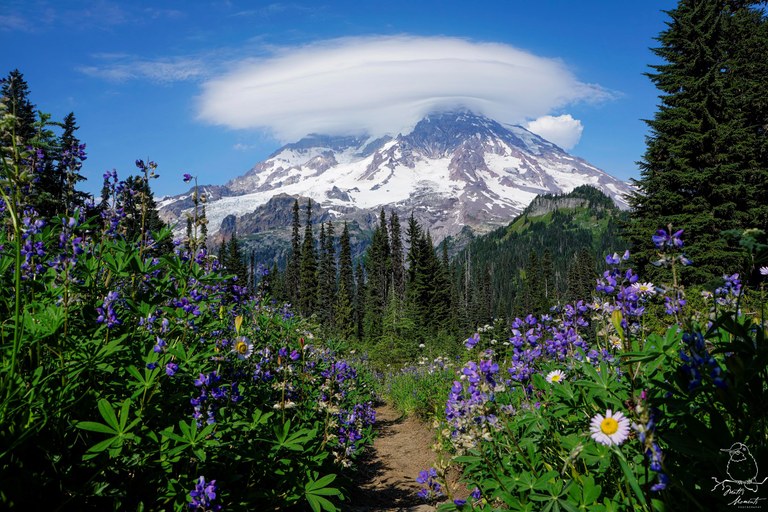
Matt was taken by the beauty of the Pacific Northwest. Photo by Matt Leaman.
“Even though it was a typical cold wet Seattle winter,” Matt said. “I don’t know, it just felt correct.”
That gut feeling — that intuition that the Pacific Northwest was the place he wanted to be — turned out to have (hiking) legs.

Matt was amazed by everything he could see on the trails in Washington — both the big stuff and the smaller stuff. Photo by Matt Leaman.
He kept coming back, visiting his best friend several times over a few years. Then, one year, the only time they could find for a visit was a week that she was going to be backpacking. She had an extra spot on the permit. Matt had never been backpacking before and had no clue where they were going, but he was up for the challenge.
That backpacking permit turned out to be for a 5-day trip in the Snow Lake zone of the Enchantments.
“As soon as we got up to the lakes — and then especially when we went to visit the core — I was just like, ‘What have I been doing with my life? Why has it not been this?’” Matt said. “And I told (my best friend) Suze that I was going to move. ‘My lease is up next spring. I’ll be here.’ She’s like, ‘Sure, I’ll believe it when I see it.’”
True to his word, Matt quit his job in Maryland that following spring, sold most of his belongings, packed up his car and drove over 2,500 miles to Seattle. And he quickly integrated into Washington’s hiking scene.
“I was hiking and backpacking nearly every weekend, and snowshoeing in the winter… There were some days I would drive out to the mountains after work and do a quick hike,” he said. “I wanted to spend as much time as I possibly could in the woods — and in the mountains and at the lakes — to find some solitude and see some beautiful things.”

Two of Matt's favorite hikes in one photo — Mount Adams, and Mount St. Helens in the background. Photo by Matt Leaman.
Matt would drive for hours to get to trailheads on the weekends, and scheduled his free time around big hikes and mountain summits like Mount St. Helens and Mount Adams. It wasn’t out of the ordinary for him to hop in the car right after work on Friday to start a two-night backpacking trip, with only a small buffer of recovery time before starting back at work on Monday — before doing it all again the following weekend.
In 2020, COVID-19 changed Matt’s daily routine, just as it did everyone else’s, and the constant hiking trips stopped. During the pandemic, he also left his job. The extra spare time and atmosphere of general uncertainty led Matt to look for new ways to enjoy the outdoors — more solitary, low-key, closer-to-home activities in the face of chaos.
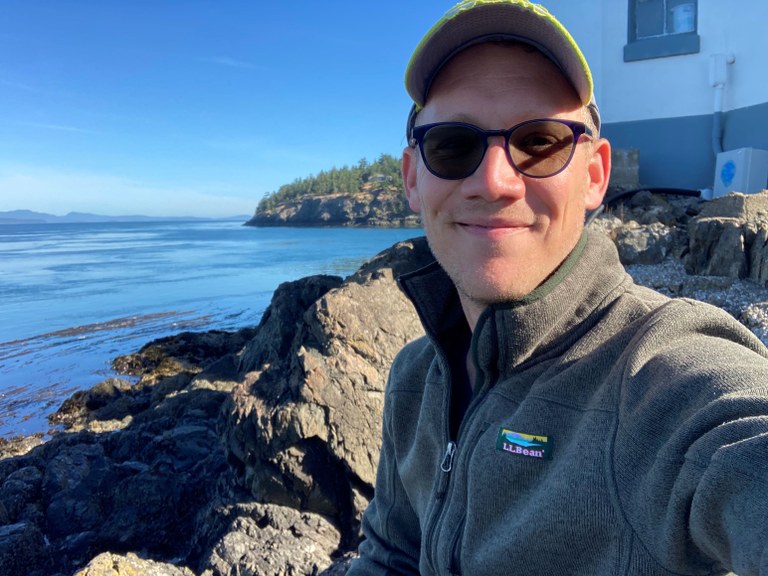
Matt started staying a little more local in his outdoor adventures when the pandemic began. Photo by Matt Leaman.
On a quiet weekend trip to a beachside cabin in Cama Beach State Park on Camano Island, Matt sat inside reading a book. He had heard that gray whales visit the Puget Sound each spring, and while he was reading, he looked out at the water every now and again, just in case he might catch a glimpse of one through the window.
To his surprise and delight, one of those times he looked up, he saw a gray whale just off the beach right in front of the cabin. He ran outside and saw it breathe before swimming away.
“It made me want to keep trying to see these whales and learn more about them,” said Matt.
After that first sighting, Matt researched where he might find whales and started traveling to Port Susan regularly, where whales are often spotted. He would sometimes hang out for hours, even when the weather was gloomy. He also spent more time reading about whales.
He learned that some whales — like some gray whales, known as the Sounders — come back almost every year and that regular whale watchers could recognize specific whales and have even named them.
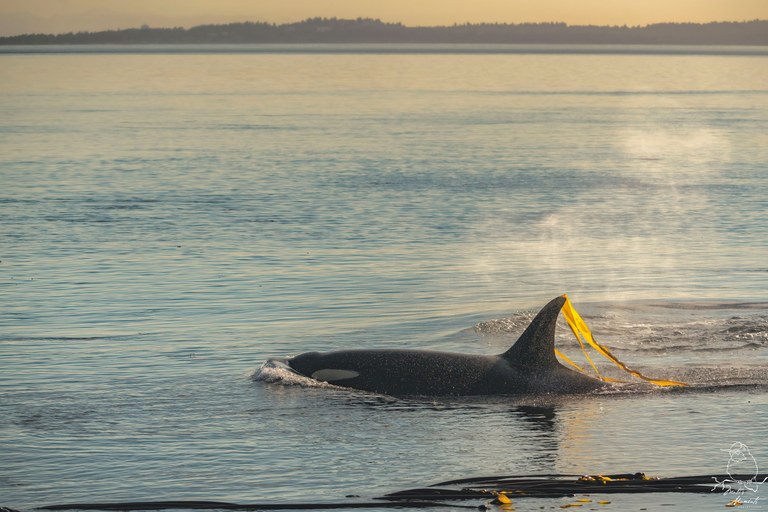
Matt never tired of watching whales — orcas, in this photo. Photo by Matt Leaman.
“Once I learned some of that stuff, it made me feel more connected to them,” Matt said. “These giant creatures live so close to us, and you can just sometimes catch a glimpse of them if you really try or if you’re just really fortunate.”
After months of whale watching on his own, Matt found out about an internship opportunity with the Orca Behavior Institute on San Juan Island.
“I was like, ‘Oh, I could apply for that. I’m already watching whales, and I don’t have a job,’” Matt said.
A few days later, while kayaking at Port Susan to — you guessed it — see some whales, Matt got a call from the institute to chat about the internship position. In the end, he got hired as one of two interns.
For 7 weeks, Matt spent all day on San Juan Island looking for orcas and recording data on their behavior. And he even found a new hobby — birdwatching.
"I was spending so much time outside just waiting for whales to show up that I ended up watching all the birds,” Matt said.
In the last week of his internship with the Orca Behavior Institute, Matt was out on a boat hoping to see some whales and a stranger chatted him up. It turned out she worked at the University of Washington School of Oceanography and she told him about a job opening. That conversation led to an interview, and then a job. Now, Matt works at the UW School of Oceanography on a team that manages two oceanographic research vessels. He even gets to ride along on international trips sometimes.

Matt has found that although he loves whale watching, birdwatching has been easier to fit into his schedule.
“You can always go somewhere and see birds because there are so many awesome parks in Seattle and the Seattle area,” Matt said. “There are cool birds and they change throughout the year. I’ve gotten really into staying more local and seeing birds and other wildlife instead of driving and hiking for hours.”
Matt has spent countless hours in Seattle parks, and he found that watching wildlife was one way to connect with others during the pandemic, a time when creating a community could be very difficult. He’s made many friends — both online and in the field — while planning and heading out on his wildlife-watching adventures.
“Something I really enjoy about staying more local and watching birds and whales is the connection with people that I get during those experiences,” Matt said. “Because we’re all trying to see the same thing, it’s a really easy thing to talk about.”
An unexpected disaster with his camera during his internship turned out to fuel Matt’s passion for photography, and even made him a better photographer.
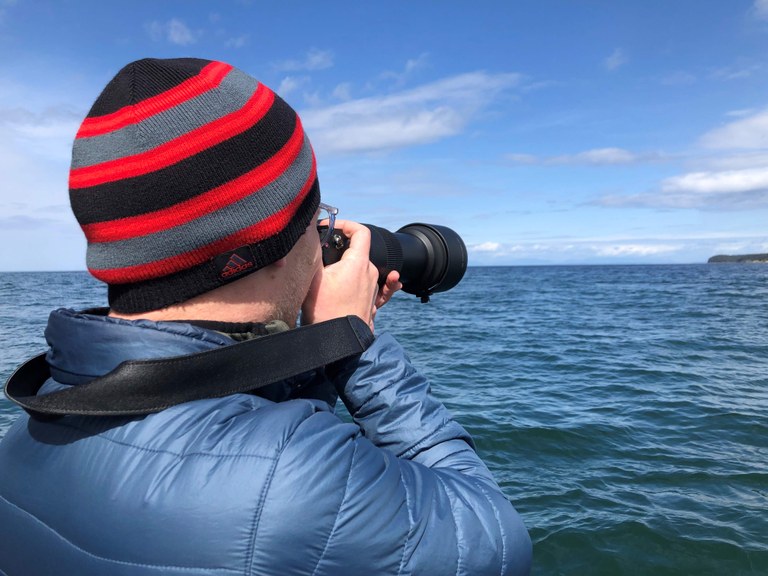
Matt's interest in photography surprisingly grew after he ruined his camera in the Salish Sea. Photo by Matt Leaman.
Since he knew he’d be watching whales round-the-clock, he had packed his camera for the internship — he had always appreciated photography for its ability to capture memories and as a way to share experiences with other people.
On his final weekend on the island, Matt dropped his camera into the Salish Sea, which ruined it. He used that as an opportunity to upgrade his photography setup and — along with that — take the time to learn more about how to take better photos.
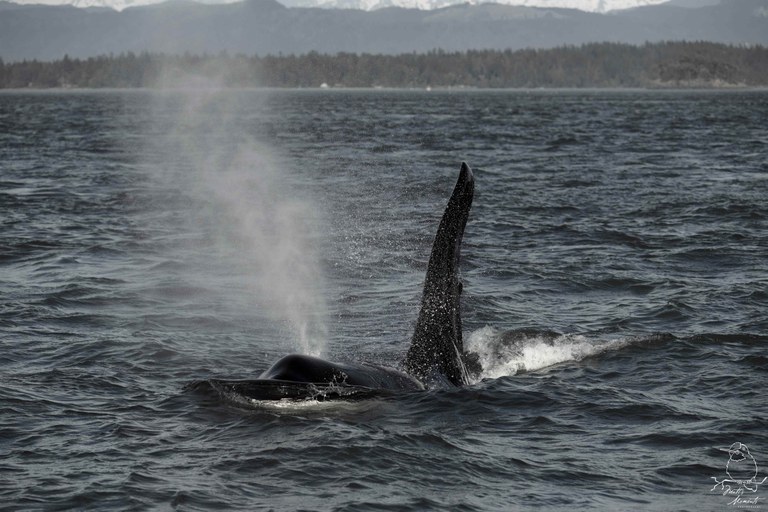
Matt plans his life around wildlife-watching these days, like with this orca. Photo by Matt Leaman.
Matt also started selling his photos as prints to support his photography hobby. As a way to give back to the world from which he derives so much happiness, he donates 10% of all sales to nature and wildlife nonprofits in the Pacific Northwest.
Sometimes, Matt thinks about how his relationship with the outdoors has changed over the last few years. Although the activities he regularly partakes in differ from before, the joy he gets from them is the same.
“Some of the experiences that I’ve had with wildlife, especially during the last few years, fill me with happiness in the same way that every time I think about how beautiful the Enchantments are makes me happy,” said Matt. “I’m still having those feelings now but in a very different experience, which is great. And I would not have the job I have now had it not been for falling in love with whales. That gray whale I saw on Camano Island is directly related to how I got my job.”
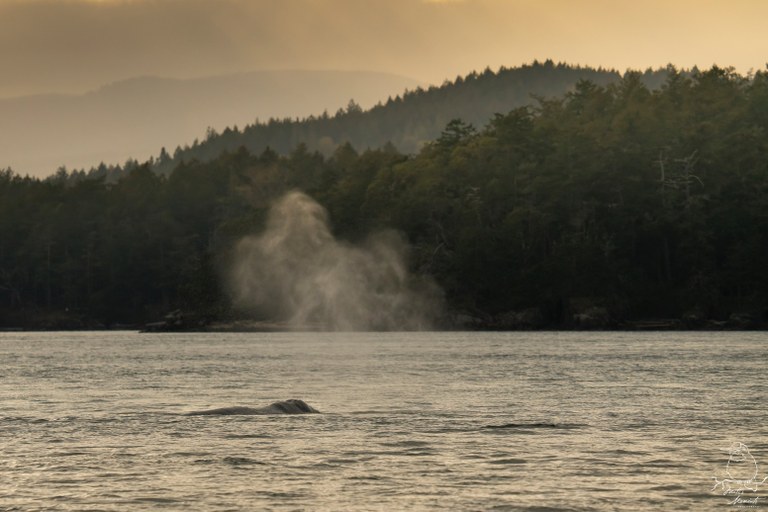
This isn't the gray whale that changed everything, but another that Matt captured in the Salish Sea. Photo by Matt Leaman.
And his feelings about how important it is to respect nature and wildlife have not changed — if anything, they strengthened as he’s slowed down.
“In every interaction with nature, consider and think about the impact you’re having on it and how you can lessen that impact,” he said.
Trails used to be the end-all-be-all of Matt’s outdoor time. Although he doesn’t hike dozens of miles a week anymore, trails are still a part of his adventuring, but often in a very different capacity. Matt can tell that his own ideas on what an outdoor adventure is have transformed — and become significantly less narrow.
“It’s really just any time I’m spending outdoors and in a more natural environment… At the beach, at a park, on a boat, in a kayak, in the mountains, anything like that,” said Matt. “Before the pandemic, it was mountains always, lakes always… It’s opened up quite a bit. Sometimes it’s just going to the park down the hill from my house to look at ducks.”